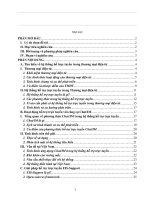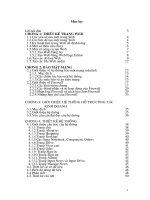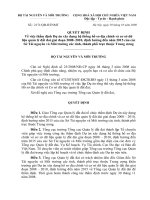Respiratory System Hệ thống hô hấp
Bạn đang xem bản rút gọn của tài liệu. Xem và tải ngay bản đầy đủ của tài liệu tại đây (2 MB, 17 trang )
Group
RESPIRATORY
SYSTEM
GROUP
RESPIRATORY SYSTEM
/ˈres.pɚ.ə.tɔːr.i
ˌsɪs.təm/
• The network of organs and tissues that help you
breathe.
• This system helps your body absorb oxygen
from the air so your organs can work.
• It also cleans waste gases, such as carbon
dioxide, from your blood.
• Common problems include allergies, diseases or
infections.
FUNCTIONS
• Helping you inhale (breathe in) and exhale
(breathe out)
• Allows you to talk and to smell.
• Warms air to match your body temperature and
moisturizes it to the humidity level your body
needs.
• Delivers oxygen to the cells in your body.
• Removes waste gases, including carbon dioxide,
from the body when you exhale.
• Protects your airways from harmful substances
and irritants.
THE PARTS OF THE RESPIRATORY SYSTEM
Mouth and nose
Sinuses /ˈsaɪ.nəs/
Openings that pull air
from outside your body
into your respiratory
system.
Hollow areas between the bones in your
head that help regulate the temperature
and humidity of the air you inhale.
Pharynx (throat)
/ˈfer.ɪŋks/
Tube that delivers air from your
mouth and nose to the trachea
(windpipe).
THE PARTS OF THE RESPIRATORY SYSTEM
Ribs
Bones that surround and
protect your lungs and
heart.
Lungs
Diaphragm
/ˈdaɪ.ə.fræm/
Muscle that helps your
lungs pull in air and push it
out.
Two organs that remove
oxygen from the air and
pass it into your blood.
THE PARTS OF THE RESPIRATORY SYSTEM
Trachea /ˈtreɪ.kiə/
Passage connecting your throat
and lungs.
Alveoli /ælˈvi əˌlaɪ/
Tiny air sacs in the lungs
where the exchange of
oxygen and carbon
dioxide takes place.
Bronchial tubes
/ˈbrɒŋ.ki.əl/ /tuːb/
Tubes at the bottom of
your windpipe that
connect into each lung.
THE PARTS OF THE RESPIRATORY SYSTEM
Bronchioles /ˈbrɑːŋ.ki.oʊl/
Small branches of the bronchial
tubes that lead to the alveoli.
Capillaries
Blood vessels in the
alveoli walls that move
oxygen and carbon
dioxide.
Alveoli
Tiny air sacs in the lungs
where the exchange of
oxygen and carbon
dioxide takes place.
THE PARTS OF THE RESPIRATORY SYSTEM
Larynx (voice box)
/ˈler.ɪŋks/
Hollow organ that allows you to talk
and make sounds when air moves
in and out.
INFLUENCE CONDITIONS
Allergies /ˈæl.ə.dʒi/: Inhaling proteins, such as dust, mold,
and pollen, can cause respiratory allergies in some people.
These proteins can cause inflammation in your airways.
Asthma /ˈæs.mə/: A chronic (long-term) disorder, asthma causes
inflammation in the airways that can make breathing difficult.
Infection /ɪnˈfekt/: Infections can lead to pneumonia
(inflammation of the lungs) or bronchitis (inflammation of the
bronchial tubes). Common respiratory infections include the flu
(influenza) or a cold.
INFLUENCE CONDITIONS
Disease: Respiratory disorders include lung cancer
and chronic obstructive pulmonary disease (COPD).
These illnesses can harm the respiratory system’s
ability to deliver oxygen throughout the body and
filter out waste gases.
Aging /ˈeɪ.dʒɪŋ/ : Lung capacity decreases as you
get older.
HOW CAN I KEEP MY
RESPIRATORY SYSTEM
HEALTHY?
You should:
• Avoid pollutants that can damage your
airways, including secondhand smoke,
chemicals and radon (a radioactive gas
that can cause cancer).
• Wear a mask if you are exposed to
fumes, dust or other types of pollutants
for an
Total Number of Cases in Viet Nam
11,521,70
8
Coronavirus disease 2019
/kəˈrəʊ.nəˌvaɪə.rəs/ /dɪˈziːz/
Is an acute infectious respiratory disease caused by the
coronavirus SARS-CoV-2 and its variants.
The main mode of transmission is person-to-person
transmission, usually via respiratory droplets that people
sneeze, cough or exhale.
Cystic fibrosis
/ˌsɪs.tɪk faɪˈbrəʊ.sɪs/
It is a life-threatening genetic disease that causes
the body to produce thick mucus. This thick
mucus can build up and clog ducts and other
ducts in the lungs, digestive tract, and pancreas.
Emphysema
/ˌem.fəˈsiː.mə/
This can be understood as a type of chronic
obstructive pulmonary disease that causes the
lungs to inflate too much
Chronic Bronchitis
/ˈkrɒn.ɪk/ /brɒŋˈkaɪ.tɪs/
Type of chronic obstructive pulmonary disease (COPD).
This is an acute bronchitis condition that is not treated
definitively, causing repeated recurrences, leading to
severe damage to the bronchial tubes.
DOCUMENTS
/> /> /> />Unit 7 from Teacher
THANK FOR
LISTENING






